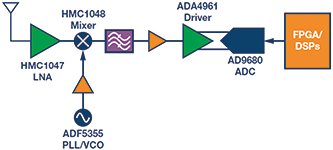
Next-generation aerospace and defence system designers are being pushed to develop advanced, highly configurable systems that combine a range of functions and requirements, integrating functionality that would have historically been implemented by separate standalone systems.
Clearly this has the benefit of reducing the number of subsystems that need to be supported by any mission platform, reducing the overall size, weight and power (SWaP), but with further need to support cognitive and real-time configurability, the challenges can seem daunting. However, a new generation of high-performance, wideband components are potentially providing a solution to this challenge, supporting the high performance levels required for each system, but with a broad enough operating range to meet the multifunction challenge.
The ultimate goal for many of these future systems is a completely software determined architecture. This allows for the implementation and mode of operation to be changed dynamically, updated in the field, or factory configured with no, or very minor, hardware changes.
The challenge is to support the superset of operational modes that the system may be required to enable. This requires that the underlying single piece of hardware is able to meet the specifications of all the possible modes of operation that may be needed.
An example of such systems in the defence world looking to combine functions are radar and communication platforms. In many cases, these systems look to support multimodes of legacy operation, but they are also starting to incorporate electronic warfare functionality.
Radar systems are looking to support electronic support measures (ESM), and communication systems looking to implement signal intelligence (SIGINT) functionality, as well as multimode radar and multi-waveform communications respectively.
In both of these examples, the systems are looking to incorporate wideband and narrowband functionality, functions that would typically drive very different requirements in terms of linearity and dynamic range, among other requirements.
To meet the overarching goal, the designer may have to trade power or size if compromises to the specifications are not acceptable.
As an example, consider an X-band radar system and an electronic intelligence system (ELINT). The radar system will typically operate over a relatively narrow frequency range, typically hundreds of MHz within the 8 GHz to 12 GHz band. In contrast, the ELINT system will typically require operating over the 2 GHz to 18 GHz range, covering all of the S, C and X frequency bands.
If the assumption is made that both implementations have to be the same size, then compromises to the performance may need to be made to support the wider frequency range and coverage of the ELINT system. Typically in this instance, the linearity or power consumption of the signal chain can be traded for bandwidth.
If this same concept is taken down to the component level, the same issues are observed. For broadband or wideband systems, typically the performance of the component is sacrificed in at least one dimension, whether that be linearity, noise performance or power.
Although there will always be some trade-off and some compromise when multiple system specifications are implemented in a single system, the next generation of RF and microwave components, as well as high-speed ADCs, will provide some relief to future system designers.
Advances in CMOS and silicon-germanium (SiGe) processes, among others, are enabling a significant increase in digital functionality to be incorporated into next-generation devices. Advanced signal processing capabilities are able to provide calibration or digital compensation functionality, in addition to flexibility, enabling the overall system performance levels to be closer to their narrowband counterparts, while maintaining the ability to be reconfigurable and utilise wider bandwidths for mode of operation as needed.
Figure 1 shows a generic wideband receiver architectural diagram based on a number of the latest RF and microwave components. Although in practice this architecture may require additional filtering and gain stages to achieve a specific application requirement, the flexibility of the underlying components enables a very wideband surveillance system architecture to be implemented.

In addition, configurable digital signal processing functionality has the ability to enable the signal chain to perform more narrowband functions when needed. Furthermore, the system can support dynamic, real-time mode changing, potentially supporting more cognitive functions in conjunction with further digital signal processing downstream.
Previously, this level of integration and associated performance was not possible. In addition, many system designers shied away from the use of direct conversion architectures, as the limitations of aspects such as image rejection over frequency and temperature could not be overcome.
The increased coupling of digital and analog, with advanced calibration and processing now integrated into these devices, provides solutions to these challenges, increasing flexibility without significantly sacrificing performance and power consumption. Although it may still be able to obtain better performance using a more narrowband, dedicated signal chain using discrete components, the gap is certainly narrowing.
The ultimate goal of a software-defined system, a single RF and microwave signal chain for all applications, would ideally be a single component such as a transceiver supporting multifunction and cognitive applications. In reality, for all systems this may still be some time away, but new advanced developments are getting closer to this goal with ever more functionality being incorporated into each new semiconductor device.
In addition to simply improving traditional RF performance, digital signal processing is providing solutions to relieve and overcome some of the multimode challenges. It may not be long before a single solution (using a single device or a cascade of wideband devices) for all applications becomes available and the drive to truly software-defined systems become a reality.
The full white paper on which this article is based can be accessed at http://dataweek.co.za/+k3418

© Technews Publishing (Pty) Ltd | All Rights Reserved